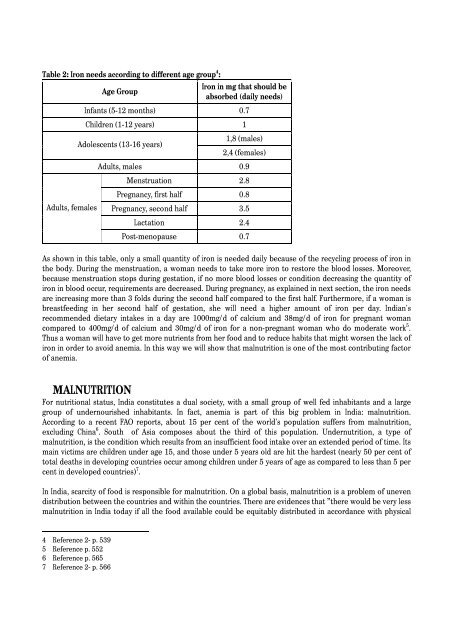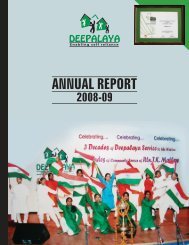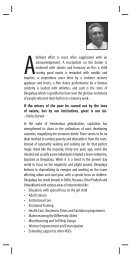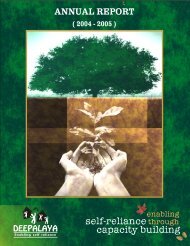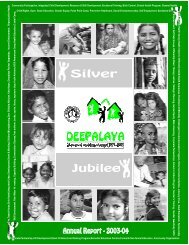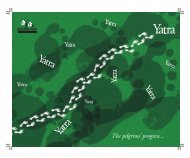Report 2011 - Deepalaya
Report 2011 - Deepalaya
Report 2011 - Deepalaya
You also want an ePaper? Increase the reach of your titles
YUMPU automatically turns print PDFs into web optimized ePapers that Google loves.
Table 2: Iron needs according to different age group 4 :<br />
Adults, females<br />
Age Group<br />
Iron in mg that should be<br />
absorbed (daily needs)<br />
Infants (5-12 months) 0.7<br />
Children (1-12 years) 1<br />
Adolescents (13-16 years)<br />
1,8 (males)<br />
2,4 (females)<br />
Adults, males 0.9<br />
Menstruation 2.8<br />
Pregnancy, first half 0.8<br />
Pregnancy, second half 3.5<br />
Lactation 2.4<br />
Post-menopause 0.7<br />
As shown in this table, only a small quantity of iron is needed daily because of the recycling process of iron in<br />
the body. During the menstruation, a woman needs to take more iron to restore the blood losses. Moreover,<br />
because menstruation stops during gestation, if no more blood losses or condition decreasing the quantity of<br />
iron in blood occur, requirements are decreased. During pregnancy, as explained in next section, the iron needs<br />
are increasing more than 3 folds during the second half compared to the first half. Furthermore, if a woman is<br />
breastfeeding in her second half of gestation, she will need a higher amount of iron per day. Indian's<br />
recommended dietary intakes in a day are 1000mg/d of calcium and 38mg/d of iron for pregnant woman<br />
compared to 400mg/d of calcium and 30mg/d of iron for a non-pregnant woman who do moderate work 5 .<br />
Thus a woman will have to get more nutrients from her food and to reduce habits that might worsen the lack of<br />
iron in order to avoid anemia. In this way we will show that malnutrition is one of the most contributing factor<br />
of anemia.<br />
MALNUTRITION<br />
For nutritional status, India constitutes a dual society, with a small group of well fed inhabitants and a large<br />
group of undernourished inhabitants. In fact, anemia is part of this big problem in India: malnutrition.<br />
According to a recent FAO reports, about 15 per cent of the world's population suffers from malnutrition,<br />
excluding China 6 . South of Asia composes about the third of this population. Undernutrition, a type of<br />
malnutrition, is the condition which results from an insufficient food intake over an extended period of time. Its<br />
main victims are children under age 15, and those under 5 years old are hit the hardest (nearly 50 per cent of<br />
total deaths in developing countries occur among children under 5 years of age as compared to less than 5 per<br />
cent in developed countries) 7 .<br />
In India, scarcity of food is responsible for malnutrition. On a global basis, malnutrition is a problem of uneven<br />
distribution between the countries and within the countries. There are evidences that ”there would be very less<br />
malnutrition in India today if all the food available could be equitably distributed in accordance with physical<br />
4 Reference 2- p. 539<br />
5 Reference p. 552<br />
6 Reference p. 565<br />
7 Reference 2- p. 566


